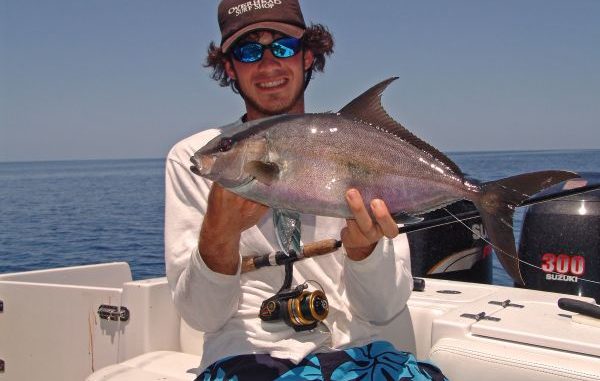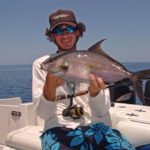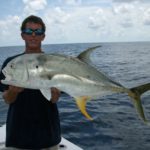
Dark-brown backs, white bellies, a faint golden stripe running nose to tail and a distinctive dark line that reaches from the eye to the anterior (front) dorsal fin are some of the defining marks of a greater amberjack (Seriola dumerili).
Others include secondary dorsal fins that are taller and rigid, and anal fins shortening into low profiles extending to just above the tail.
With adults running about 30 to 70 pounds — occasional bruisers passing 100 — this fish is the biggest of an offshore clan that also includes these jacks:
• Lesser Amberjack (Seriola fasciata) — Generally, a scaled-down version of a greater amberjack, the lesser AJs eye stripe doesn’t quite reach the dorsal fin.
Maximum size is about a foot in length and a couple of pounds. Lesser AJs sometime end up on sabiki rigs or small diamond jigs meant for hardtails.
• Almaco Jack (Seriola rivoliana) — A common bycatch with light tackle, almacos have similar coloration as greater AJs, but the lateral stripe is usually less pronounced and the eye shadow is on par with that of the lesser amberjack.
In addition to a shorter, taller profile and darker overall appearance, the almaco’s secondary dorsal fin narrows and reaches farther than AJs of similar size.
• Banded Rudderfish (Seriola zonata) — Take the basic AJ shape and fin structure, wash out most of the dark-brown coloration and paint dark, vertical bars along the sides, and you have this sporty little jack that grows about twice as big as the lesser amberjack but not as large as an almaco.
Yet another reef dweller, the pilotfish, is often confused with banded rudderfish, but the former lacks the characteristic eye stripe and sports only a set of dorsal spikes in place of an anterior dorsal fin. Also, the pilotfish has a deeply forked tail, and its bands extend onto the dorsal and anal fins.
• Jack Crevalle (Caranx hippos) — This one’s like that weird cousin that shows up uninvited to the Christmas party. Visibly differing from the amberjack and its extended family, jacks (as they’re generically called) fight just as hard as an AJ, and the ones that live offshore reach stud proportions.
The crevalle’s dorsal and anal fin structure resembles that of an AJ, but distinctly longer pectorals are a clear identifier. Also, a jack crevalle trades the golden lateral stripe and dark eye shadow, for a yellowish tint and a black spot on each gill cover.


